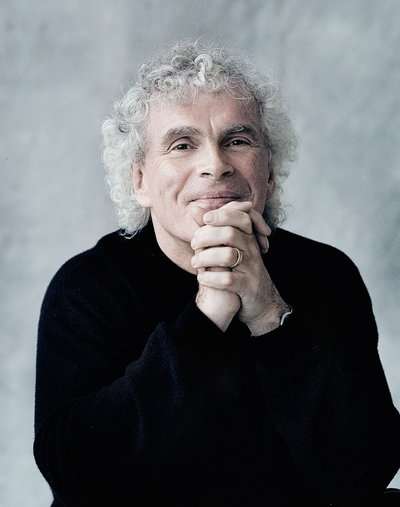|
Back
Much of a Glorious Muchness New York
Isaac Stern Auditorium, Carnegie Hall
02/24/2012 -
Anton Bruckner: Symphony Number 9 in D Minor (with reconstructed Finale, New York premiere)
Berlin Philharmonic Orchestra, Sir Simon Rattle (Music Director and Conductor)

Sir S. Rattle (© www.simon-rattle.de)
The revision quantities of Anton Bruckner’s nine symphonies–some by himself, others by editors editing other editors–are literally incalculable. But no symphony has become so contentious as the “three-movement” final Ninth Symphony which has been transformed these past decades into four complete movements.
Supposedly, Bruckner, suffering from pleurisy and/or feeling that he had made his peace with God, created the “last movement” as a final Adagio. The symphony itself went through the usual revisions, but when it was discovered that Bruckner had left page after page of completely orchestrated passages of a fourth movement, then editors and musicologists had a three-decade-long carnival of revisions, lasting to this day.
Actually, the “final” revised finale has been recorded several times. But even this has been–according to the annotators of this program–”exhaustively fine-tuned in multiple revisions...to its definitive form,” reconstructed by Nicola Samale, Giuseppe Mazzuca, and Benjamin-Gunnar Cohrs in 1983, premiered in 1999 and revised several times to new edition in 2011.
That is an optimist’s view. While Sir Simon Rattle’s performance certainly seemed definitive, nothing nothing–in Brucknerian canon can possibly be called final.
Future redactors, scholars, discoveries of missing pages (apparently some pages were stolen by autograph-hunters), conductors will add another tympani roll, augment a three-trumpet chorale with an added trombone, and add extra measures of quivering quavering strings.
In the meantime, though, Sir Simon is doing the honors, and last night, he turned the familiar opening three movements into a spacious extravaganza, reverberating in Carnegie Hall to a packed audience.
Nor was it anything but overwhelming to hear this massive orchestra at its glorious loudest for the climaxes, to hear those trumpets calling to the heavens, and to wonder, as Sir Simon took these seething buildups up and down the scale.
Did Sir Simon sometimes turn the opening into a concerto for tympani? The percussionist let himself go wild under the agonizing themes. Did the second movement sometimes seem a little Mendelssohinan? Such wistfulness was part of it.
And if Sir Simon sometimes lost the line of the “final” Adagio, then let us allow Mr. Bruckner his due, to have put as many feelings, climaxes, pastorales and perhaps confessions to his Lord as he could.
But that was of course not the problem. New Yorkers were hearing, for the first time, that final final final finale. And to make sense, it had to say something which Bruckner didn’t say in the first three movements.
I was not totally convinced. We had ecstatic chorales, more brass, and–most interesting of all–memories of Bruckner past. A direct quote from the first theme of the opening, another direct quote from the opening of his Te Deum (at first the descending chords seemed a quote from the last movement of Beethoven’s Ninth.)
Even the original themes seemed like descants from music of the preceding three movements.
It was held together by dotted thymic pulse which gave unity even when the music itself seemed a bit disjointed on first hearing.
But the main question is whether the new last movement added anything to Bruckner’s religious orations in the original symphony.
To those accustomed to the usual three-movement work, the finale might have seemed a much of a muchness, even a superfluity. On the other hand, Rattle conducted with such conviction, and the new themes were so spaciously triumphant in themselves, that we could allow ourselves to indulge in another 25-odd minutes of Bruckner–like helping ourselves to another helping of delicious chocolate cake, even if the taste isn’t quite so delicious.
After it was over, I left Carnegie Hall immediately. It wasn’t out of disrespect for Sir Simon–far from it. But the sound of 95 minutes of the orchestra added to another 15 minutes with thousands of hands smacking against each other, was too much.
A glorious Bruckner indeed. But the drops of pianissimo raindrops drops on New York’s pavements was an equally glorious respite.
Harry Rolnick
|